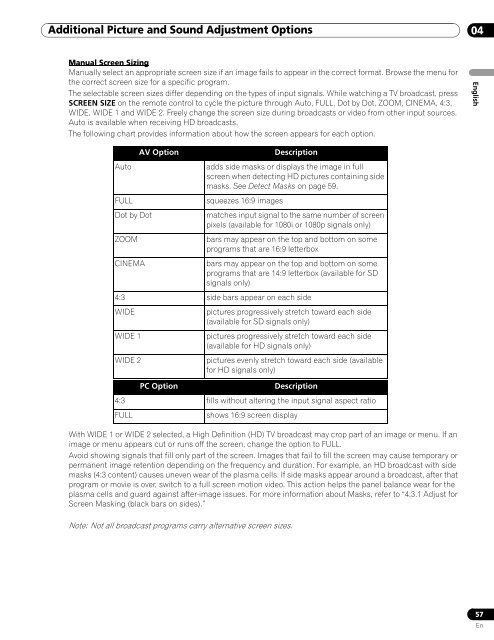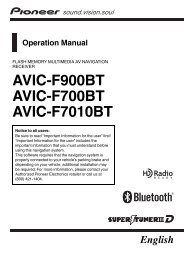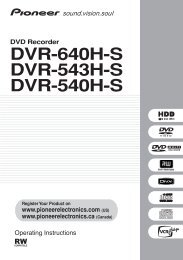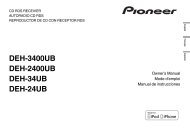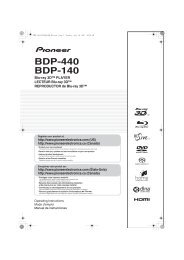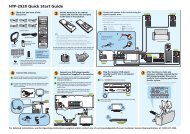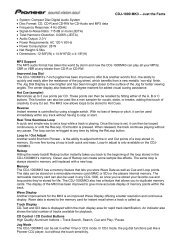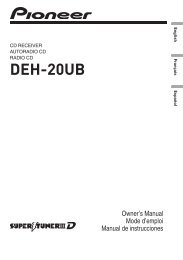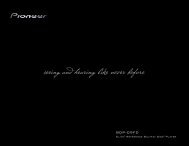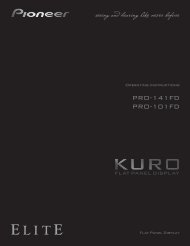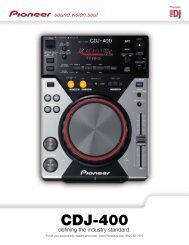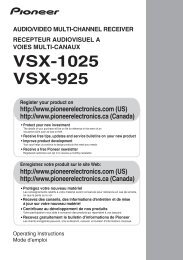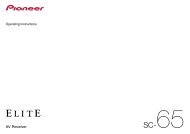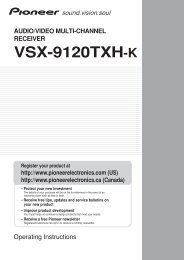- Page 2 and 3:
IMPORTANT The lightning flash with
- Page 4 and 5:
4 En TABLE OF CONTENTS 3.5 Block Pr
- Page 6 and 7: 01 Introduction to the 20FD Series
- Page 8 and 9: 01 Introduction to the 20FD Series
- Page 10 and 11: 01 Introduction to the 20FD Series
- Page 12 and 13: 01 Introduction to the 20FD Series
- Page 14 and 15: 02 Install Your Flat Panel TV 14 En
- Page 16 and 17: 02 Install Your Flat Panel TV 16 En
- Page 18 and 19: 02 Install Your Flat Panel TV 18 En
- Page 20 and 21: 02 Install Your Flat Panel TV 20 En
- Page 22 and 23: 02 Install Your Flat Panel TV 22 En
- Page 24 and 25: 02 Install Your Flat Panel TV 24 En
- Page 26 and 27: 02 Install Your Flat Panel TV 26 En
- Page 28 and 29: 02 Install Your Flat Panel TV 28 En
- Page 30 and 31: 02 Install Your Flat Panel TV 30 En
- Page 32 and 33: 03 Basic Operations For Television
- Page 34 and 35: 03 Basic Operations For Television
- Page 36 and 37: 03 Basic Operations For Television
- Page 38 and 39: 03 Basic Operations For Television
- Page 40 and 41: 03 Basic Operations For Television
- Page 42 and 43: 03 Basic Operations For Television
- Page 44 and 45: 03 Basic Operations For Television
- Page 46 and 47: 03 Basic Operations For Television
- Page 48 and 49: 03 Basic Operations For Television
- Page 50 and 51: 03 Basic Operations For Television
- Page 52 and 53: 03 Basic Operations For Television
- Page 54 and 55: 04 Additional Picture and Sound Adj
- Page 58 and 59: 04 Additional Picture and Sound Adj
- Page 60 and 61: 04 Additional Picture and Sound Adj
- Page 62 and 63: 04 Additional Picture and Sound Adj
- Page 64 and 65: 04 Additional Picture and Sound Adj
- Page 66 and 67: 04 Additional Picture and Sound Adj
- Page 68 and 69: 04 Additional Picture and Sound Adj
- Page 70 and 71: 05 Use Other Equipment With Your Fl
- Page 72 and 73: 05 Use Other Equipment With Your Fl
- Page 74 and 75: 05 Use Other Equipment With Your Fl
- Page 76 and 77: 05 Use Other Equipment With Your Fl
- Page 78 and 79: 05 Use Other Equipment With Your Fl
- Page 80 and 81: 05 Use Other Equipment With Your Fl
- Page 82 and 83: 05 Use Other Equipment With Your Fl
- Page 84 and 85: 05 Use Other Equipment With Your Fl
- Page 86 and 87: 05 Use Other Equipment With Your Fl
- Page 88 and 89: 05 Use Other Equipment With Your Fl
- Page 90 and 91: 05 Use Other Equipment With Your Fl
- Page 92 and 93: 05 Use Other Equipment With Your Fl
- Page 94 and 95: 05 Use Other Equipment With Your Fl
- Page 96 and 97: 05 Use Other Equipment With Your Fl
- Page 98 and 99: 05 Use Other Equipment With Your Fl
- Page 100 and 101: 05 Use Other Equipment With Your Fl
- Page 102 and 103: 05 Use Other Equipment With Your Fl
- Page 104 and 105: 05 Use Other Equipment With Your Fl
- Page 106 and 107:
05 Use Other Equipment With Your Fl
- Page 108 and 109:
05 Use Other Equipment With Your Fl
- Page 110 and 111:
05 Use Other Equipment With Your Fl
- Page 112 and 113:
05 Use Other Equipment With Your Fl
- Page 114 and 115:
06 Helpful Information 114 En Why i
- Page 116 and 117:
06 Helpful Information 116 En Pictu
- Page 118 and 119:
06 Helpful Information 118 En Home
- Page 120 and 121:
06 Helpful Information 120 En If th
- Page 122 and 123:
07 Cautions and Warnings 122 En Vie
- Page 124 and 125:
07 Cautions and Warnings 124 En 7.7
- Page 126 and 127:
08 Appendix 126 En 8 Appendix 8.1 R
- Page 128 and 129:
08 Appendix 128 En 8.2 Manufacturer
- Page 130 and 131:
08 Appendix 130 En 8.2.4 VCR (Brand
- Page 132 and 133:
08 Appendix 132 En 8.2.7 PVR Brand/
- Page 134 and 135:
08 Appendix 134 En 8.2.11 DVD (Bran
- Page 136 and 137:
08 Appendix 136 En . * conforms to
- Page 138 and 139:
08 Appendix 138 En 1. Redistributio
- Page 140 and 141:
08 Appendix 140 En libpng versions
- Page 142 and 143:
08 Appendix 142 En HEREUNDER IS ON
- Page 144 and 145:
08 Appendix 144 En Program), you in
- Page 146 and 147:
08 Appendix 146 En Preamble The lic
- Page 148 and 149:
08 Appendix 148 En ordinary GNU Gen
- Page 150 and 151:
08 Appendix 150 En Each version is
- Page 152 and 153:
08 Appendix 152 En 8.4 Glossary HDM
- Page 154 and 155:
08 Appendix 154 En 8.5 Index Numeri
- Page 156 and 157:
IMPORTANT Ce symbole de l’éclair
- Page 158 and 159:
4 Fr TABLE DES MATIÈRES 3.5 Blocag
- Page 160 and 161:
01 Présentation des téléviseurs
- Page 162 and 163:
01 Présentation des téléviseurs
- Page 164 and 165:
01 Présentation des téléviseurs
- Page 166 and 167:
01 Présentation des téléviseurs
- Page 168 and 169:
02 Installation du téléviseur à
- Page 170 and 171:
02 Installation du téléviseur à
- Page 172 and 173:
02 Installation du téléviseur à
- Page 174 and 175:
02 Installation du téléviseur à
- Page 176 and 177:
02 Installation du téléviseur à
- Page 178 and 179:
02 Installation du téléviseur à
- Page 180 and 181:
02 Installation du téléviseur à
- Page 182 and 183:
02 Installation du téléviseur à
- Page 184 and 185:
02 Installation du téléviseur à
- Page 186 and 187:
03 Opérations de base pour regarde
- Page 188 and 189:
03 Opérations de base pour regarde
- Page 190 and 191:
03 Opérations de base pour regarde
- Page 192 and 193:
03 Opérations de base pour regarde
- Page 194 and 195:
03 Opérations de base pour regarde
- Page 196 and 197:
03 Opérations de base pour regarde
- Page 198 and 199:
03 Opérations de base pour regarde
- Page 200 and 201:
03 Opérations de base pour regarde
- Page 202 and 203:
03 Opérations de base pour regarde
- Page 204 and 205:
03 Opérations de base pour regarde
- Page 206 and 207:
03 Opérations de base pour regarde
- Page 208 and 209:
04 Options de réglage supplémenta
- Page 210 and 211:
04 Options de réglage supplémenta
- Page 212 and 213:
04 Options de réglage supplémenta
- Page 214 and 215:
04 Options de réglage supplémenta
- Page 216 and 217:
04 Options de réglage supplémenta
- Page 218 and 219:
04 Options de réglage supplémenta
- Page 220 and 221:
04 Options de réglage supplémenta
- Page 222 and 223:
04 Options de réglage supplémenta
- Page 224 and 225:
05 Utilisation d’autres appareils
- Page 226 and 227:
05 Utilisation d’autres appareils
- Page 228 and 229:
05 Utilisation d’autres appareils
- Page 230 and 231:
05 Utilisation d’autres appareils
- Page 232 and 233:
05 Utilisation d’autres appareils
- Page 234 and 235:
05 Utilisation d’autres appareils
- Page 236 and 237:
05 Utilisation d’autres appareils
- Page 238 and 239:
05 Utilisation d’autres appareils
- Page 240 and 241:
05 Utilisation d’autres appareils
- Page 242 and 243:
05 Utilisation d’autres appareils
- Page 244 and 245:
05 Utilisation d’autres appareils
- Page 246 and 247:
05 Utilisation d’autres appareils
- Page 248 and 249:
05 Utilisation d’autres appareils
- Page 250 and 251:
05 Utilisation d’autres appareils
- Page 252 and 253:
05 Utilisation d’autres appareils
- Page 254 and 255:
05 Utilisation d’autres appareils
- Page 256 and 257:
05 Utilisation d’autres appareils
- Page 258 and 259:
05 Utilisation d’autres appareils
- Page 260 and 261:
05 Utilisation d’autres appareils
- Page 262 and 263:
05 Utilisation d’autres appareils
- Page 264 and 265:
05 Utilisation d’autres appareils
- Page 266 and 267:
05 Utilisation d’autres appareils
- Page 268 and 269:
06 Informations utiles 114 Fr Pourq
- Page 270 and 271:
06 Informations utiles 116 Fr Image
- Page 272 and 273:
06 Informations utiles 118 Fr Home
- Page 274 and 275:
06 Informations utiles 120 Fr Si le
- Page 276 and 277:
07 Précautions et avertissements 1
- Page 278 and 279:
07 Précautions et avertissements 1
- Page 280 and 281:
08 Annexe 126 Fr 8 Annexe 8.1 Table
- Page 282 and 283:
08 Annexe 128 Fr 8.2 Codes de fabri
- Page 284 and 285:
08 Annexe 130 Fr 8.2.4 Magnétoscop
- Page 286 and 287:
08 Annexe 132 Fr 8.2.7 PVR Marque/C
- Page 288 and 289:
08 Annexe 134 Fr 8.2.11 DVD (Marque
- Page 290 and 291:
08 Annexe 136 Fr . * conforme à HD
- Page 292 and 293:
08 Annexe 138 Fr Ethernet Une techn
- Page 294:
08 Annexe 140 Fr 8.6 Informations s
- Page 297 and 298:
CONTENIDO Congratulaciones por su c
- Page 299 and 300:
CONTENIDO 5.5 Conexión de una cons
- Page 301 and 302:
Introducción a los Televisores de
- Page 303 and 304:
Introducción a los Televisores de
- Page 305 and 306:
Introducción a los Televisores de
- Page 307 and 308:
Introducción a los Televisores de
- Page 309 and 310:
Instalación de su televisor de pan
- Page 311 and 312:
Instalación de su televisor de pan
- Page 313 and 314:
Instalación de su televisor de pan
- Page 315 and 316:
Instalación de su televisor de pan
- Page 317 and 318:
Instalación de su televisor de pan
- Page 319 and 320:
Instalación de su televisor de pan
- Page 321 and 322:
Instalación de su televisor de pan
- Page 323 and 324:
Instalación de su televisor de pan
- Page 325 and 326:
Operaciones básicas para contempla
- Page 327 and 328:
Operaciones básicas para contempla
- Page 329 and 330:
Operaciones básicas para contempla
- Page 331 and 332:
Operaciones básicas para contempla
- Page 333 and 334:
Operaciones básicas para contempla
- Page 335 and 336:
Operaciones básicas para contempla
- Page 337 and 338:
Operaciones básicas para contempla
- Page 339 and 340:
Operaciones básicas para contempla
- Page 341 and 342:
Operaciones básicas para contempla
- Page 343 and 344:
Operaciones básicas para contempla
- Page 345 and 346:
Operaciones básicas para contempla
- Page 347 and 348:
Operaciones básicas para contempla
- Page 349 and 350:
Opciones adicionales de ajuste de l
- Page 351 and 352:
Opciones adicionales de ajuste de l
- Page 353 and 354:
Opciones adicionales de ajuste de l
- Page 355 and 356:
Opciones adicionales de ajuste de l
- Page 357 and 358:
Opciones adicionales de ajuste de l
- Page 359 and 360:
Opciones adicionales de ajuste de l
- Page 361 and 362:
Opciones adicionales de ajuste de l
- Page 363 and 364:
Utilización de otros equipos con s
- Page 365 and 366:
Utilización de otros equipos con s
- Page 367 and 368:
Utilización de otros equipos con s
- Page 369 and 370:
Utilización de otros equipos con s
- Page 371 and 372:
Utilización de otros equipos con s
- Page 373 and 374:
Utilización de otros equipos con s
- Page 375 and 376:
Utilización de otros equipos con s
- Page 377 and 378:
Utilización de otros equipos con s
- Page 379 and 380:
Utilización de otros equipos con s
- Page 381 and 382:
Utilización de otros equipos con s
- Page 383 and 384:
Utilización de otros equipos con s
- Page 385 and 386:
Utilización de otros equipos con s
- Page 387 and 388:
Utilización de otros equipos con s
- Page 389 and 390:
Utilización de otros equipos con s
- Page 391 and 392:
Utilización de otros equipos con s
- Page 393 and 394:
Utilización de otros equipos con s
- Page 395 and 396:
Utilización de otros equipos con s
- Page 397 and 398:
Utilización de otros equipos con s
- Page 399 and 400:
Utilización de otros equipos con s
- Page 401 and 402:
Utilización de otros equipos con s
- Page 403 and 404:
Utilización de otros equipos con s
- Page 405 and 406:
Utilización de otros equipos con s
- Page 407 and 408:
Información útil 06 6 Informació
- Page 409 and 410:
Información útil 06 6.4 Solución
- Page 411 and 412:
Información útil 06 Home Media Ga
- Page 413 and 414:
Información útil 06 Home Media Ga
- Page 415 and 416:
Precauciones y advertencias 07 7 Pr
- Page 417 and 418:
Precauciones y advertencias 07 En c
- Page 419 and 420:
Precauciones y advertencias 07 PREC
- Page 421 and 422:
Apéndice 8.1.4 Clasificaciones can
- Page 423 and 424:
Apéndice 8.2.3 Videograbadora (Mar
- Page 425 and 426:
Apéndice 8.2.5 Videograbadora (Mar
- Page 427 and 428:
Apéndice 8.2.10 DVD (Marcas A - N)
- Page 429 and 430:
Apéndice 8.3 Especificaciones Tele
- Page 431 and 432:
Apéndice 8.4 Glosario HDMI High-De
- Page 433 and 434:
Apéndice 08 8.5 Índice Números 1
- Page 435:
Register Your Product on http://www


